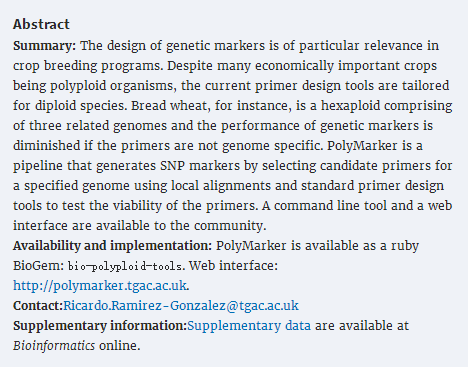发布者:primerbank 时间:2017-09-22 浏览量:1159
Ricardo H. Ramirez-Gonzalez Cristobal Uauy Mario Caccamo
Bioinformatics, Volume 31,
Issue 12, 15 June 2015, Pages 2038–2039,https://doi.org/10.1093/bioinformatics/btv069
Published: 02 February 2015
Article
history

Breeding programs rely on dense genetic maps with markers (e.g. SNPs) that can be used to identify the presence or absence of specific alleles in homozygous or heterozygous state. Standard primer design tools are designed to work in diploids, where genome duplications are rare. Wheat is a polyploid composed of three genomes (A, B and D; referred to as homoeologues) that are related (between 96 and 98% sequence identity), yet distinct. This creates a problem for the design of PCR primers specific to an individual homoeologue. A common approach to circumvent this issue is to manually design primers with a genome specific variant at the 3′ of the primer to increase specificity. We introduce PolyMarker, a tool to automate the design of genome specific primers, thereby reducing the time invested in this process. To make PolyMarker accessible to scientists and breeders, we developed a web server where custom SNPs can be submitted for the design of genome specific assays.
First, PolyMarker converts the input marker information (chromosome arm, sequence adjacent to the SNP and parental alleles) into a fasta file with the sequences that can be queried to the genomic reference. The search is performed with Exonerate (Slater and Birney, 2005), with the option –ryo(roll your own format) to facilitate the parsing. The region flanking the SNP, twice the size of the maximum amplification product (200 bp for amplification products up to 100 bp), on the best hit of each chromosome is extracted. A local alignment between homoeologues and paralogues, is refined with MAFFT (Katoh and Standley, 2013), executed using the binder provided in bioruby.
The local alignment is used to produce a mask containing all the variations across homoeologues and the input sequence (Supplementary Fig. S1). The mask indicates the type of variation on each position: (i) Specific: homoeologous polymorphism which is only present in the target genome; (ii) Semi-specific: homoeologous polymorphism which is found in more than one genome but it discriminates against one of the off-target genomes or when not all the homoeologous sequences were found; (iii) Non-specific: when no variation is found across homoeologues; (iv) Homoeologous: The target SNP is present across different chromosomes and; (v) Non-homoeologous: The target SNP is not present across chromosomes. PolyMarker default is to design a three-primer assay for KASP genotyping (LGC Genomics, 2013), that comprises a common primer and two allele-specific primers. Since the allele-specific primers are restricted in position, the common primer is used to incorporate the chromosome specific variants when possible.
To test if the primer candidates are viable Primer3 (Rozen and Skaletsky, 2000) is invoked using the genomic reference of the target chromosome. The starting positions of the primers to distinguish between alleles is selected with the SEQUENCE_FORCE_LEFT_END option of primer3. To design the common primer the option SEQUENCE_FORCE_RIGHT_END is used on two runs of primer3, for the chromosome specific and semi-specific primers. A final run of primer3 is executed without the SEQUENCE_FORCE_RIGHT_END option to find viable primers. After the primers are tested with Primer3, PolyMarker selects a primer pair with the highest specificity.
PolyMarker is a pipeline (Fig. 1) written as a Biogem (Bonnal et al., 2012), extending bioruby (Goto et al., 2010) to extract regions from fasta files and to support operations on nucleotide sequences with IUPAC ambiguity codes (Cornish-Bowden, 1985).

Our objective was to make PolyMarker accessible via a web interface where breeders and researchers could submit their markers to custom-design genome-specific SNP assays. A typical output is described in the supplemental material. Batch submission of several markers is possible. The web interface is implemented in java with MySQL database the markers information. The source code of the web interface and the daemon are available for the community to set up a private server.
The pipeline was developed originally to design KASP assays to validate putative SNPs from RNA-Seq data [28 out of 35 assays polymorphic (80%; Ramirez-Gonzalez et al., 2014)]. PolyMarker was also used to generate KASP assays for the 81 587 markers in the iSelect array from Wang et al. (2014) (Supplemental Material).
PolyMarker is a pipeline that facilitates the design of primers in polyploid organisms. A web interface is available to design primers for hexaploid wheat. The use of PolyMarker reduces the time spent designing genome specific assays and highlighting homoeologous SNPs.
The authors thank Sebastian Wilzbach for the help setting up the BioJS component for sequence alignments. The authors thank Nicholas Bird, Christopher Burt and Miroslav Valarik for feedback.
RHRG is supported by a Norwich Research Park PhD Studentship and The Genome Analysis Centre Funding and Maintenance Grant. The work was supported by grants BB/J004588/1 and BB/J003743/1 from the UK Biotechnology and Biological Sciences Research Council (BBSRC).